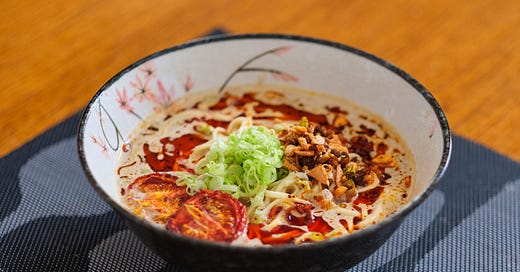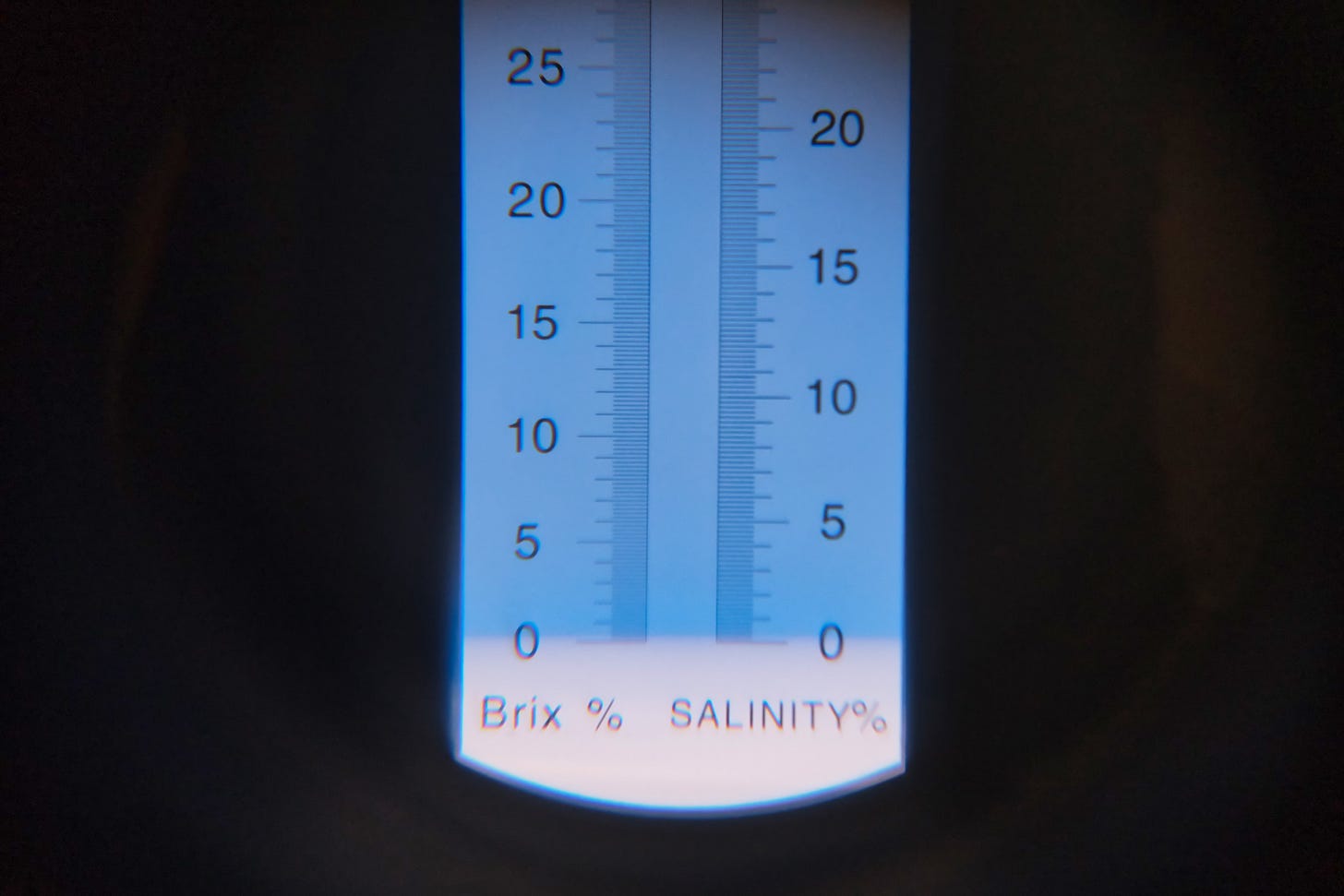Vegan Ramen Makeover
A plant-based take on Ramen. How to make a mushrooms-forward rich and creamy soup for everyone (with a simple hyper-umami tomato tare).
If you’re not yet a subscriber and like The Ramen Bowl, leave your email to start receiving all the new posts directly in your inbox! 👇
Is vegan ramen a thing?
Short answer: freaking yes.
You should try vegan ramen.
While I am a big fan of chicken and pork-based soups, I wanted to make something different this time (and I also have some vegetarian friends I want to convert to ramen, yup).
Vegetarian and vegan bowls are spreading as ramen itself becomes more and more popular all around the world. Talking about ramen bars I have visited in Europe so far, I would say it has become pretty standard to serve vegetarian soup, and it's quite ordinary to find at least one veg option on the menu.
When done correctly, veg ramen has a fair potential to reach up to its meat-based versions. Plus, it's good to reach a broader audience, and I would assume it should be the basics, at this time, for restaurants to offer veg options.
We could, arguably, define today's style as Yasai Tomato Shio Ramen.
Yasai stands for veggies in Japanese. I use many in this recipe, but the very base of the soup will be mushroom juice.
The tare is a simple Shio one based on tomato water. If you never had tomato water, it is basically the liquid extracted from the tomato, removing the pulp. It is umami, fresh, tastes like fresh tomato, a little acidic, and a little sweet. As part of the Shio framework, we add a salty component and enhance its already present umami by adding salt and MSG. Simple as that!
What does it taste like? The result is a kind of thick, creamy, nutty, earthy soup, finished by a slightly acidic and sweet tomatoey note. Like all ramen, it's full of umami and complex flavor.
The recipe is quite long to write down, so I would rather let you dive into it already. I'll leave my comments at the end!
Ingredients
You will see I am admittedly omitting a “noodles” section down here. I was not in the mood to make fresh noodles at home, blame me. I suggest you use the best curly, thin, alkaline, chewy, and slippery fresh noodles you can find out there!
Soup
Makes around 6 portions of 350mL each.
You will need a pressure cooker for this, or you’ll need to cook for ~3x more time and evaluate the water content evaporating, as well as an immersion blender, a fine strainer, and a nut milk bag. This last one is not necessary, but it helps extract as much of the soup content as possible.
1 kg cremini mushrooms
10g dried Porcini mushrooms
20g dried Shiitake mushrooms
1 big yellow onion, peeled and cut into quarters
1 big carrot, peeled and roughly chopped
1 medium potato, peeled and roughly chopped
A quarter of an apple, without seeds
5 garlic cloves, smashed
A knob of Ginger
3 bay leaves (fresh ones are better)
15g Kombu
100g hazelnuts
200g soy milk
2 liters of water
Tare
You will need an immersion blender, a fine strainer, like a Chinois, and a nut milk bag. If you don’t have a nut milk bag, try to simply double-strain the pulp.
Fresh tomatoes (I used 4 medium-small tomatoes to get a final 200 g of tare)
Salt
MSG
Aroma Oil
120 mL of neutral vegetable oil (I used the rapeseed one, but feel free to choose the one you like)
A bunch of green onions, chopped
3 garlic cloves, chopped
1 tbsp of Sichuan peppercorns
2 pinches of oregano
1 pinch of powdered ginger
2 tsp of Gochugaru (Korean chili peppers)
Salt
MSG
Toppings
Fresh tomatoes, cut in half
Salt
Pepper
Olive oil
The onion and garlic chips from the aromatic oil
Negi (the green part of spring onions)
Preparation
Soup
Soak the hazelnuts in water overnight.
Clean the fresh mushrooms.
Add the fresh mushrooms and the water to a pressure cooker, bring to pressure on high heat, then turn down to low heat and cook for around 1 hour.
Depressurize the pot and remove the lid.
Briefly soak the dried mushrooms in water to remove the dust.
Add the dried mushrooms, soy milk, Kombu, and the remaining aromatics (onion, carrot, apple, potato, garlic, bay leaves, ginger) to the pot.
Bring to around 80 degrees Celsius (just below a simmer) and keep that temperature, stirring occasionally, for about 30 minutes.
After time has passed, remove the Kombu.
Simmer the remaining ingredients on low heat for another 30 minutes.
Let the pot cool down a bit so you can blend the content without steaming.
Add the hazelnuts to the broth.
Blend for a couple of minutes.
Strain. If you can, squeeze the compost through a nut milk bag.
Notes & Storage
The final soup can be stored in the fridge for up to 3 days or in the freezer for up to 6 months.
A note on density. The final density of this soup should be a little above 5 Brix.
For those who are not familiar, the Brix degree is a measure of the solids dissolved in a liquid. The common tool to measure on the Brix scale is called a refractometer. It calculates the index of refraction of a liquid, that is briefly the angle at which light passes through our soup.
I know that feels a bit too much science and a little cooking, and you are probably right thinking this if you are only going to make a complex ramen once. Truth is, on the other hand, the more you cook complex stuff, the more you want them to be replicable, and that includes being sure the final result of your hours-long soup is somewhat identical to the last time you made it.
Most home cooks won't have to measure density. Just taste the soup. It should feel a little creamy and soft. If you ever need one to make ramen or beer at home, some easy-to-use hand refractometers are available online at an appealing low price.
Tare (Tomato Water)
You will have to calculate the Salt and MSG weight in a percentage of the resulting weight of the extracted tomato water.
Doing the math, you should use around 10% of the weight in salt and 6% in glutamic acid, MSG. This is a general framework valid for nearly all Shio tare out there.
For instance, for 200 grams of tomato water, you can add around 20 grams of salt and 12 grams of MSG. For a sweeter result, I once rounded those numbers down to 15 and 10 grams. You have some room to play and get the real umami beast out of this tare.
Wash the tomatoes, pat dry, then cut into quarters.
Blend the tomatoes for a minute until they become pulp.
Strain through a fine strainer and a nut milk bag. Let it pour by itself. You must not agitate, move, or press the pulp. This might take several minutes, so I usually simply leave it all in the fridge for a while.
Add the calculated salt (10%) and MSG (6%) to the tomato water and whisk until dissolved.
Notes & Storage
Store this tare in an airtight container in the fridge for up to 3 days.
Note that the result should not be red-colored. Instead, it should be nearly transparent. If it is still red and has pulp consistency, strain it again through a finer mesh.
If you don’t have a nut milk bag, try to simply double-strain the pulp.
Aroma Oil
This chili oil is quite simple, though pretty much aromatic. I didn't want this to be extra hot and have permanent heat, so I used Korean chili flakes, renowned for having a milder heat but earthier flavor than many others.
If you feel you need something more complex, see my 5 Spices aroma oil and try using hotter chili flakes.
Add the chili flakes, a pinch of salt, and a pinch of MSG into a heat-resistant container. Set aside.
Add the oil to a cold saucepan together with the green onion and garlic.
Cook on low heat, stirring occasionally, until the onions and garlic are brown and fragrant, just a little before burnt.
Remove the onions and garlic with a skimmer and lay them on a paper towel to dry. These will make our crispy topping chips later.
Add the Sichuan peppers, oregano, and ginger to the pan, and let it cook on low heat for around 10 minutes.
Turn off the heat and, while still hot, strain and pour the oil over the chili flakes from point 1.
Allow to cool, then transfer to a sealable container.
Keep the onion and garlic chips from step 4! You can use it as a topping for this and many other recipes.
Toppings
This bowl includes 3 toppings.
There’s not much to say for two of them:
The onion and garlic chips are the result of the aromatic oil from the previous step. Simply season them with a little pinch of salt.
The fresh green onions only need to be cut nicely thin. I sliced it into rings, but you choose how to do it.
As a third topping, I chose roasted tomatoes to recall the slightly acidic and hyper-umami tomato water tare we are using. To make them is quite straightforward.
Roasted Tomatoes
Preheat your oven to 120 °C.
Slice the tomato in half lengthwise (the result is two round, big disks of tomato).
Season the tomato with salt and pepper, and drizzle with olive oil. Then place them on a baking sheet.
Roast the tomatoes in the oven for around 2-3 hours until they are soft, colored, and have shrunk in size.
Serving
Now that you have prepared everything from above, it’s time to assemble everything together and plate your bowl.
Get your mise en place ready (cut the green onions, clean your workspace, re-heat the tomatoes, get the tare and oil out of the fridge and ready).
Have some water boiling (for noodles).
Preheat the bowl at the lowest temperature in the oven. If your bowl is cold, it will cool your ramen.
Heat the soup (and, optionally, blend with an immersion blender for a minute to create a nice cappuccino-like foam).
Start cooking the noodles. Then proceed with the following steps 1-2 minutes right before the noodles are done. Don’t let the soup sit in the bowl for too long or it will lose the heat!
Add 30 mL (~2 tbsp) of tare at the bottom of the bowl.
Add 15 mL (~1 tbsp) of oil at the bottom with the tare.
Around 350 mL of soup go in the bowl.
Strain (very well) the cooked noodles and add them to the soup.
Drizzle another 15 mL (~1 tbsp) of oil on the top, before toppings.
Add your toppings as the last thing.
Serve!
Conclusion?
Are you not convinced, yet?
— The Ramen Bowl - ◡ -
If you’re not yet a subscriber and like The Ramen Bowl, leave your email to start receiving all the new posts directly in your inbox! 👇








I will let you know💕
I love the use of the tomato tare. Is that also used in meat Ramens?